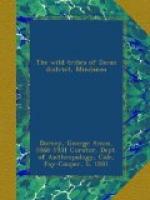According to their own stories, the original home of the tribe was along the river Mapula which flows into the Tuganay near its source. Governor Bolton tells of hearing, while in this section, of a people called Dedaanum “who were small and black and had curly hair,” but who had all been killed by the Tugauanum. He was also informed that a numerous tribe of very small black people called Tugniah lived on the headwaters of the river Omiern, which flows north of the Libagawan. They were said to live in trees, to plant nothing, and to subsist on sago flour. “Their bolos are like sabers and they use lances, bows, and arrows.”
The Governor classes the Tugauanum as Ata “since they speak the same language” but he adds “they are probably the same race as the Libabaoan.” This latter people are elsewhere in his notes referred to as Guibabauon or Dibabaoan. They live along the headwaters of the Tagum river and are, he believes, a mixture of Ata and Mandaya.[1]
[1] The writer believes that the Libabaoan are probably the same as the Divavaoan who are classed as a branch of the Mandaya. See p. 165.
From one source we learn that the Ata are small, in many respects resembling the Negrito; that they are timid and are either nomads or build their houses high in the branches of trees. Another writer tells us that they are a superior type, with aquiline noses, thick beards, and are tall. “They are very brave and hold their own with the Moro.” We are also told that they cultivate the soil and build good houses.
The estimates concerning their numbers are equally conflicting. Governor Bolton gives the population as six thousand; the report of the Philippine Commission for 1900 credits them with eight thousand, while Father Gisbert believed that they aggregated “not less than twenty thousand souls.”
The divergent reports are due to the fact that up to the year 1886 only one village of this people had been visited,[2] and since that time only a few hasty trips have been made into their territory.
[2] BLAIR and ROBERTSON, Vol. XLIII, pp. 242-3.
From our present information it seems probable that the Ata are descendants of an early invading people who intermarried first with the early Negrito inhabitants, and later with other tribes with which they came in contact. They have been free borrowers from their neighbors in all respects, and hence we find them occupying all the steps from the nomad condition of the pygmy blacks to the highly specialized life of the Guianga.
The following account of their beliefs was extracted from letters written by Governor Bolton. He fails to designate the section from which the information was gathered, but its similarity to Bagobo and Guianga makes it probable that the account comes from the Ata dwelling near those people. Considerable variation will doubtless be found in other districts.




